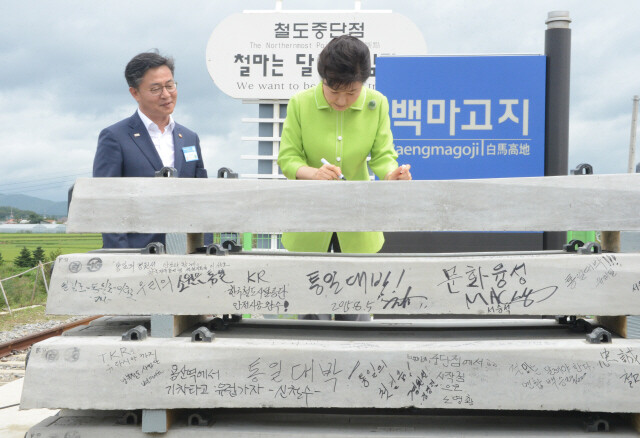hankyoreh
Links to other country sites 다른 나라 사이트 링크
S. Korea suspends restoration of railway that would connect Seoul with North Korea

The South Korean government has tentatively suspended the restoration project on the southern section of the Gyeongwon train line that once ran from Yongsan in Seoul to Wonsan in North Korea, officials confirm.
During the big groundbreaking ceremony held for the restoration project last August, South Korean President Park Geun-hye remarked that “the project should be promoted with the greatest urgency to prepare for making the Eurasia Initiative a reality.” But the project appears to be an unintended casualty of the gridlock in inter-Korean relations following North Korea’s fourth nuclear test.
During the press briefing on June 17, South Korean Unification Ministry Spokesperson Jeong Joon-hee explained that construction work to restore the southern section of the Gyeongwon Line had been “temporarily suspended.”
“When we set the budget for the restoration project, we estimated that land acquisition would cost 9 billion won (US$7.69 million), based on the assessed price of land. But after the project got underway, prices in the area rose, and the appraised value of land increased to 27 billion won,” Jeong said. Since the price of land has skyrocketed, the government finds itself needing to boost the project’s budget.
“Work on design and land acquisition is underway,” Jeong said. “The restoration project itself has not been canceled.”
But in reality, the project might as well be canceled. “We will be reviewing the timeframe for resuming construction as we keep track of budget deliberations and inter-Korean relations,” Jeong said.
This could be taken to mean that, even if the Ministry is granted the additional budget it needs to acquire the land, it will not resume construction if inter-Korean relations do not improve.
“Since the majority of the construction area is located inside the civilian control line, we have no choice but to consider the threat of North Korea’s nuclear test and repeated provocations,” Jeong said.
It can be concluded that the government’s decision to halt construction is related to the policy framework the government has adopted since North Korea’s fourth nuclear test, which involves treating North Korean denuclearization as the greatest priority, shutting down all inter-Korean exchange and cooperation and focusing on putting pressure on the North.
On Aug. 5, 2015, President Park attended the groundbreaking ceremony for the southern section of the Gyeongwon Line, which took place at Baekmagoji Station in Cheorwon County.
“If the Gyeongwon Line is restored, the mighty sound of the whistle will echo throughout the Korean Peninsula and the continent [of Asia], bringing the news that the Eurasia Initiative is on the march,” Park said during the ceremony.
Experts offer two ways of viewing the government’s decision to halt construction.
“Park put on a show about restoring the Gyeongwon Line while disregarding the Gyeongui Line and Donghae Line, which the Kim Dae-jung (1998-2003) and Roh Moo-hyun (2003-2008) administrations worked to restore. Now Park is showing her true colors,” said a former government official.
“Restoring the Gyeongwon Line is the cheapest and fastest way to connect the Korean Peninsula with Europe,” said Ahn Byeong-min, director of the Research Center of Eurasia and North Korea Infrastructure at the Korea Transport Institute.
“Despite the factor of North Korea’s nuclear weapons and missiles, we need to keep moving ahead with the restoration project on the southern section of the railroad as part of the larger vision of building a rail network in Northeast Asia and a land bridge between Asia and Europe,” Ahn said.
By Lee Je-hun, staff reporter
Please direct questions or comments to [english@hani.co.kr]

Editorial・opinion
![[Column] Has Korea, too, crossed the Rubicon on China? [Column] Has Korea, too, crossed the Rubicon on China?](https://flexible.img.hani.co.kr/flexible/normal/500/300/imgdb/original/2024/0419/9317135153409185.jpg) [Column] Has Korea, too, crossed the Rubicon on China?
[Column] Has Korea, too, crossed the Rubicon on China?![[Correspondent’s column] In Japan’s alliance with US, echoes of its past alliances with UK [Correspondent’s column] In Japan’s alliance with US, echoes of its past alliances with UK](https://flexible.img.hani.co.kr/flexible/normal/500/300/imgdb/original/2024/0419/2317135166563519.jpg) [Correspondent’s column] In Japan’s alliance with US, echoes of its past alliances with UK
[Correspondent’s column] In Japan’s alliance with US, echoes of its past alliances with UK- [Editorial] Does Yoon think the Korean public is wrong?
- [Editorial] As it bolsters its alliance with US, Japan must be accountable for past
- [Guest essay] Amending the Constitution is Yoon’s key to leaving office in public’s good graces
- [Editorial] 10 years on, lessons of Sewol tragedy must never be forgotten
- [Column] A death blow to Korea’s prosecutor politics
- [Correspondent’s column] The US and the end of Japanese pacifism
- [Guest essay] How Korea turned its trainee doctors into monsters
- [Guest essay] As someone who helped forge Seoul-Moscow ties, their status today troubles me
Most viewed articles
- 1[Column] The clock is ticking for Korea’s first lady
- 2After 2 months of delayed, denied medical care, Koreans worry worst may be yet to come
- 3[Column] Has Korea, too, crossed the Rubicon on China?
- 4[Correspondent’s column] In Japan’s alliance with US, echoes of its past alliances with UK
- 5Samsung barricades office as unionized workers strike for better conditions
- 6All eyes on Xiaomi after it pulls off EV that Apple couldn’t
- 7US overtakes China as Korea’s top export market, prompting trade sanction jitters
- 8Hong Se-hwa, voice for tolerance whose memoir of exile touched a chord, dies at 76
- 9[Photo] Smile ambassador, you’re on camera
- 10[Editorial] When the choice is kids or career, Korea will never overcome birth rate woes